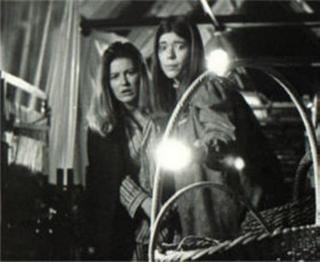
JOURNEY INTO MIDNIGHT (1968)
Dirs: Alan Gibson, Roy Ward Baker
A somewhat unusual TV horror film, shot in England and originally intended as a pilot for a weekly horror series, Journey Into Midnight consists of two tales linked by witty and arch introductions from Sebastian Cabot (better known as Family Affair's Mr. French). Cabot would later go on to host a short-lived NBC supernatural series entitled first Ghost Story, then in mid-season changed to Circle of Fear. The show may be long-forgotten but Journey has found new life through, improbably enough, screenings on the Fox Movie Channel.
The first section of the film features Chad Everett as a smug American attending a masquerade soiree at a mysterious country estate. Although the segment hints of a sort of sinister ambiguity with unsettling personal enigmas, much like the tone of Robert Aickman's brilliant short stories, the narrative quickly collapses and nosedives into a predictable yawn of an ending. The only chiefly memorable aspects are the lush production design and the moody use of the English countryscapes.
Journey is saved however in its excellent second hour directed by veteran Hammer Films and Amicus Productions horror director Roy Ward Baker (The Vampire Lovers, Scars of Dracula, Asylum, Vault of Horror, And Now the Screaming Starts among many others) and scripted by Robert Bloch (Psycho, The House that Dripped Blood, The Skull). Once again Julie Harris lends her prodigious talents in the service of small screen horror, portraying a lonely rich widow desperate to contact her beloved husband via seance. Her young personal assistant (the beautiful and chic Tracy Reed) recommends her boyfriend for the job of watchguard; Tom Adams plays a detective specializing in exposing occult frauds (the sort of niche employment found alas only in the cinema). Essentially a smooth variation on the double themes of the dastardly ladykiller and the chicanery of fake spiritualists and mediums, "The Indian Spirit Guide" benefits as a whle from the strength of its parts.
Adams and Reed make a charmingly evil duo, Harris is marvelous as always (playing her stock character at first broadly, then adding shades of complexity and poignant affectations to her performance) and the script is smart and very briskly paced. Baker's direction shows a professional restraint with little of the vulgarities and abuse of the zoom lens he often employed. Perhaps the greatest moments though are the final 15 minutes, when Catherine Lacey is introduced as the aged character Miss Sarah Prinn. Late in her career Lacey, having begun in the 1930s with Hitchcock and other noted British directors, turned often to horror film roles, perhaps the only ones available to her. As in films as diverse in quality as The Servant (1963), The Sorcerers (1967) and The Mummy's Shroud (1967), the regal actress takes command of every scene in which she appears. A regional English entertainer who confined herself to roles in her homeland, Lacey reminds us in this cameo performance of how engaging a screen personality can be, and makes us at least long for a wider and more accesible filmography than she left behind.









